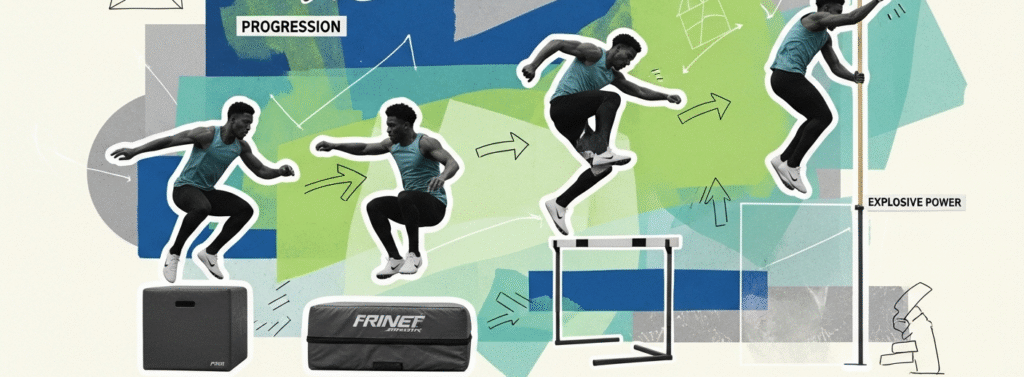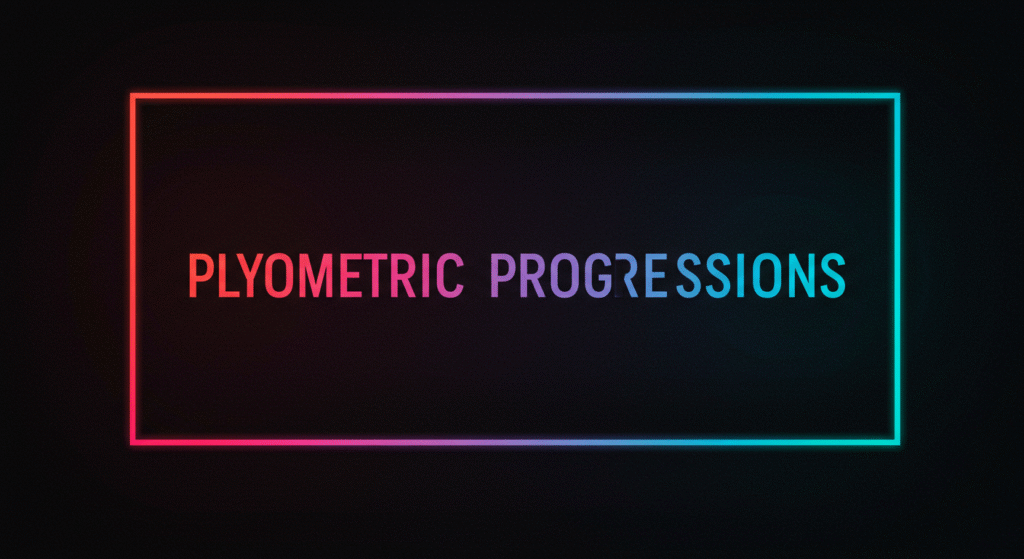Plyometric Progressions for High Jumpers: Introduction
High jumpers require exceptional explosive power and vertical leap to excel in their performance. Plyometric training is a cornerstone in developing these attributes, offering dynamic exercises that improve muscle responsiveness and power output. This article explores advanced plyometric progressions tailored for high jump athletes, revealing comprehensive training strategies to dramatically enhance explosive power and vertical jump height.
The high jump represents one of track and field’s most technically demanding events, where success hinges on an athlete’s ability to convert horizontal momentum into vertical elevation. Behind every successful clearance lies countless hours of specialized training, with plyometrics standing as perhaps the most critical component for developing the explosive power necessary to defy gravity.
While basic plyometric exercises benefit athletes across all disciplines, high jumpers require carefully structured progressions that specifically target the unique biomechanical demands of their event. These advanced plyometric drills for high jump athletes aren’t merely about jumping higher—they’re about training the neuromuscular system to engage more muscle fibers more rapidly, optimizing the stretch-shortening cycle that powers the takeoff phase.
Let’s explore how structured plyometric training for high jump performance can transform an athlete’s capabilities, providing a roadmap that progresses from foundational strength development to specialized movement patterns that directly translate to increased vertical jump height and improved bar clearance.
Plyometric Progressions for High Jumpers: Lower Body Strengthening Exercises
Building a solid foundation of lower body strength is essential for effective plyometric training in high jumpers. Before high jumpers can safely and effectively engage in advanced plyometric drills, they must develop substantial baseline strength in the primary muscle groups responsible for explosive vertical movement.
The connection between lower body strength and plyometric performance cannot be overstated. Research consistently demonstrates that athletes with greater maximal strength achieve superior results from plyometric training programs. This is particularly relevant for high jumpers, where a strength-to-weight ratio directly influences vertical leap potential.
Squats and deadlifts represent cornerstone exercises for developing the posterior chain strength essential for explosive movements. For high jumpers specifically, back squats should progress to a depth that mirrors the takeoff position while maintaining proper form. Beginning with 3-4 sets of 6-8 repetitions at 70-80% of one-repetition maximum allows for both strength development and technical mastery. As strength increases, periodized training blocks can incorporate heavier loads (85-90% 1RM) with lower repetitions to maximize neural adaptations critical for power development.
Deadlifts, particularly trap bar variations that reduce lumbar stress while maintaining training benefits, develop the hip extension power crucial for vertical jump performance. A progression of 3-4 sets of 5-6 repetitions performed with deliberate control during the eccentric phase and maximal intent during the concentric phase optimizes strength carryover to plyometric movements.
Unilateral exercises address the asymmetrical nature of high jump takeoffs. Split squats, walking lunges, and single-leg Romanian deadlifts should be incorporated weekly to identify and correct imbalances between the drive leg and swing leg. These movements enhance stability at the knee and ankle joints while developing the single-leg power necessary for successful takeoffs. Progressive overload through increased resistance rather than repetitions is recommended, with 2-3 sets of 8-10 repetitions per leg providing optimal stimulus without excessive fatigue.
- Incorporate squats and deadlifts to enhance overall leg strength.
- Focus on unilateral movements like lunges to address muscle imbalances.

Plyometric Progressions for High Jumpers: Progressive Jump Drills
Structured jump drills help in systematically increasing vertical leap and power through a carefully designed progression model. For high jumpers, this progression should follow a four-phase approach that gradually increases intensity while maintaining technical proficiency.
Phase one focuses on foundational plyometric skills through basic jump exercises. Box jumps represent an excellent starting point, allowing athletes to develop proper landing mechanics while building concentric power. Begin with moderate heights (18-24 inches) and emphasize soft landings with minimal ground contact time. Depth jumps introduce the critical stretch-shortening cycle by having athletes step off an elevated platform (12-18 inches initially) and immediately rebound into a maximal vertical jump. These exercises should be performed 2-3 times weekly with 3-4 sets of 6-8 repetitions, focusing on quality rather than quantity.
As proficiency increases, phase two introduces continuous jump variations. Repeated hurdle jumps train the body to maintain power output across multiple contacts, directly transferring to the approach phase of the high jump. Arrange 4-6 hurdles at appropriate heights (starting at 24-30 inches) and progress by reducing the distance between hurdles rather than increasing height. Bounding exercises develop horizontal power that translates to approach speed. Begin with alternate-leg bounds for distance over 20-30 meters, focusing on powerful extension through each contact.
Phase three incorporates more complex movements that mirror the specific demands of high jumping. Single-leg bounding replicates the takeoff mechanics by training the drive leg to generate maximal force while the swing leg provides momentum. Start with 3 sets of 5-8 bounds per leg, gradually increasing distance rather than repetitions. Tuck jumps develop the explosive hip flexion necessary for efficient bar clearance. Perform these with maximal effort in sets of 8-10 repetitions, emphasizing height over speed.
The final phase introduces sport-specific plyometric drills for high jump athletes. Approach jumps combine horizontal speed with vertical elevation, requiring athletes to perform abbreviated approach runs (3-5 steps) culminating in a maximal vertical jump. Scissor jumps train the coordination between the drive leg and swing leg during takeoff. These advanced drills should be performed when the athlete is fresh, typically early in a training session, with adequate recovery between sets (2-3 minutes) to maintain maximal effort.
- Begin with basic jump exercises such as box jumps and depth jumps.
- Gradually introduce more complex movements like single-leg bounding and tuck jumps.
Plyometric Progressions for High Jumpers: Upper Body Plyometrics
While lower body development understandably dominates high jump training discussions, engaging the upper body through plyometric training for high jump performance significantly enhances overall athleticism and technique execution. Upper body plyometrics develop the arm drive and shoulder rotation that contribute substantially to vertical displacement during takeoff and bar clearance phases.
Explosive push-ups represent the foundation of upper body plyometric development. These exercises train the chest, shoulders, and triceps to generate force rapidly—muscles that actively contribute to the arm swing during takeoff. Begin with traditional clap push-ups, performing 3 sets of 6-8 repetitions with emphasis on explosive concentric movement. As proficiency increases, progress to more challenging variations such as depth push-ups (lowering the body from an elevated position to the floor, then explosively pressing up) and plyometric push-ups with rotation, which develop the thoracic mobility essential for Fosbury Flop technique.
Medicine ball training offers perhaps the most sport-specific upper body plyometric stimulus for high jumpers. Overhead throws develop the shoulder extension and trunk rotation that directly transfer to arm action during takeoff. Using a 2-4kg medicine ball (adjusted based on athlete strength), perform overhead throws against a wall or with a partner for 3-4 sets of 8-10 repetitions. Rotational throws, where the athlete explosively rotates the torso while releasing the ball, enhance the connection between lower body power and upper body action.
Sideward medicine ball throws particularly benefit high jumpers by developing the lateral power needed for efficient bar clearance in the Fosbury Flop technique. Standing perpendicular to a wall, the athlete explosively throws the ball sideways, mimicking the rotational forces experienced during the flight phase of the jump. These should be performed for 3 sets of 6-8 repetitions per side, focusing on coordination between hip rotation and arm action.
Pull-based plyometric exercises complete the upper body development cycle. Explosive pull-ups, where the athlete accelerates the upward phase to momentarily release the grip, train the latissimus dorsi and biceps to contract rapidly. These muscle groups contribute to arm positioning during the flight phase. Start with 3 sets of 4-6 repetitions, emphasizing maximal acceleration rather than repetition volume. For less advanced athletes, suspended rowing with explosive concentric movement provides a scalable alternative.
These upper body plyometric progressions should be integrated into training programs 2-3 times weekly, ideally on days that also include lower body plyometric work to develop whole-body coordination and timing. As with all plyometric training, quality of movement takes precedence over volume, with adequate recovery between sets to maintain power output.
- Perform explosive push-ups to develop upper body power.
- Incorporate medicine ball throws to improve coordination and strength.

Plyometric Progressions for High Jumpers: Conclusion
Advanced plyometric training is instrumental for high jumpers aiming to elevate their explosive power and vertical jump height. By systematically progressing through targeted jump drills, strengthening lower body muscles, incorporating upper body plyometrics, and maintaining flexibility, athletes can significantly enhance their performance. Additionally, prioritizing recovery and nutrition ensures sustainable progress and reduces the risk of injury.
The progressive nature of effective plyometric training for high jump performance cannot be overemphasized. Athletes must resist the temptation to advance too quickly through plyometric progressions, as doing so often leads to compromised technique and increased injury risk. Instead, mastery at each level creates the neuromuscular foundation necessary for success at the next stage of development.
Coaching oversight represents a critical component of advanced plyometric implementation. Even experienced athletes benefit from external feedback on movement quality and landing mechanics, particularly as fatigue accumulates. Video analysis provides an invaluable tool for assessing technique and ensuring that the transfer from plyometric drills to actual high jump performance remains optimal.
Individualization must guide program design, with factors such as training age, competition schedule, anatomical structure, and injury history influencing the selection and progression of plyometric drills. What works for one high jumper may prove ineffective or even detrimental for another, highlighting the importance of responsive program design that evolves based on observed outcomes and athlete feedback.
Perhaps most importantly, high jumpers must recognize that plyometric training represents one component of a comprehensive development program. Technical training, general strength work, psychological preparation, and appropriate competition exposure all contribute to peak performance. The most successful athletes integrate these elements into a coherent training structure that addresses all performance factors simultaneously.
With consistent application of these plyometric progressions and supporting strategies, high jumpers can dramatically enhance their explosive capabilities, pushing the boundaries of their vertical potential. Embrace this comprehensive approach to plyometric training for high jump performance, and watch as your body develops the extraordinary power needed to reach new heights in your athletic career.
Coach Otto is a certified track and field coach with over 15 years of experience working with high jumpers at high school, collegiate, and elite levels.

